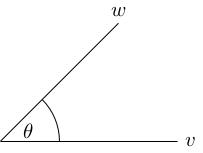An -by- matrix is orthogonal if .
11. Dot product, 3
11. Dot product, 3
Orthogonal matrices
This is equivalent to saying that:
-
the columns of , considered as column vectors, are orthogonal to one another, and
-
each column has length one when considered as a vector.
The matrix is orthogonal:
If is orthogonal then the geometric transformation of defined by preserves dot products, i.e. .
In particular, orthogonal matrices preserve lengths of vectors. This is because and orthogonal matrices preserve dot products.
The sorts of transformations you should have in mind when you think of orthogonal matrices are rotations, reflections and combinations of rotations and reflections.
We now turn to the proof of the formula where is the angle between and .
The "proof" I'll give is more of an intuitive argument. I'll point out where the dodgy bits are as we go on.
The angle between and is defined by taking the plane spanned by and and taking the angle between them inside that plane. Therefore without loss of generality, we can assume and are in the standard . ( This is where the dodgy bit is: technically, we need to check that the plane spanned by and is the same, geometrically (isometric to) the standard ; this would require us to appeal to something like Gram-Schmidt orthogonalisation, which you'll see in a later course on linear algebra.)
Further, we can rotate using our 2-by-2 rotation matrix so that points in the positive -direction. We can do this without changing the angle (because rotations preserve angles) and without changing the dot product (because rotations are orthogonal, so don't change dot products).

Finally, compute because . We have because points along the positive -axis. We also have . So overall we have .
If you were disturbed by my claim that rotations preserve angles without justification, you should have been even more disturbed by the fact that I didn't actually define angles in the plane at all. This is not intended as a complete rigorous derivation from axioms, but as an appeal to your geometric intuition.